
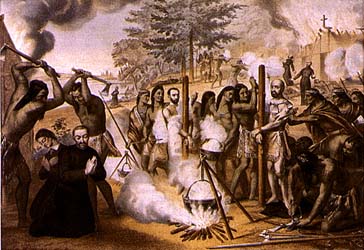 Exploring the roots
of our "guilt"
Exploring the roots
of our "guilt"
The campaign that sets out to assail our traditions and belittle our
heroes will end by forbidding them altogether. In June, 1998, Reuters News
Service reported that Honduran Indians in Tegucigalpa intended to try
Christopher
Columbus before an - ahem - "Indigenous People's Tribunal." As
is so often the case with tribunals, the decision was a foregone
conclusion:
"It will culminate in the execution of the explorer with bows and
arrows on Columbus Day on October 12." Unfortunately, we just don't
know whether this act of vegeance, 500 years after the fact, was ever
carried
out. At the end of October, Honduras was devastated by Hurricane Mitch.
Tegucigalpa was hardest hit of all.
 Champlain's astrolabe lost 1613 - found 1867
near the Ottawa River
This is the smallest of 35 surviving
astrolabes
dated to the early XVIIth century.
Champlain's astrolabe lost 1613 - found 1867
near the Ottawa River
This is the smallest of 35 surviving
astrolabes
dated to the early XVIIth century.
Our simplistic (not to say simple-minded) grasp of history-as-a-cartoon
permits "aboriginal restitution and retribution issues" to first
cloud, then eclipse the accomplishments of our European ancestors, while
the suffering and privation that defined the New World experience for most
Europeans is callously dismissed. If indigenous people are presumed to
have enjoyed a God-given right to defend "their" soil from the
polluting tread of European boots, why are we forbidden the bloodless
"luxury"
of merely discussing present-day numerical and cultural swamping? Or do
the forces of political correctitude instinctively gravitate toward, and
confine their outrage to, a time frame more congenial to them -- say, 500
years ago, during the height of the Inquisition? Europeans may have "won"
the battle, but the side making reparation payments is generally
considered
to have "lost the war".
Writing in Newsweek, November 6, 1995, Jerry
Adler
attempts to debunk a little of the "nobility" a cartoon culture
demands of aboriginal histories: "To read about a 12-year-old girl
plied with liquor and left on a frigid mountaintop to die is to experience
a revulsion that no degree of moral relativism can rationalize away. A
revulsion, however, tinged with the faint, grim satisfaction of finding
scientific evidence of an atrocity perpetrated in America that cannot by
any stretch of logic be even remotely blamed on the Europeans. ...
Accounts
of an Aztec priest ripping the beating heart out of a human offering was
one of the great arguments for Christianizing the continent. In more
recent
decades, though, Western culture has made a high-minded effort to avoid
sensationalizing such potentially embarrassing spectacles. But, even more
amazing is the realization that at the same time that Western culture was
attempting to sanitize Indian culture, it was brutally and without mercy
savaging itself.. It was, and still is, committing cultural suicide."
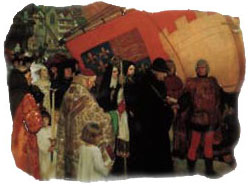 It's past
time for us to acknowledge the superb achievement the European Voyages
of Discovery represented. Exploration had captured the European
imagination.
Those star-crossed lovers of the medaieval world, Heloise and Abelard,
named their "love child" Astrolabe, as a tribute to the mariner's
aid, newly reintroduced from classical Greece. Our "own" John
Cabot, who gave Newfoundland its name in 1497, was inspired to sail after
reading of wondrous marvels in the Marco Polo journals. The men who set
sail for unknown and uncharted worlds in frail wooden ships defy our
present
day understanding of the very word "courage". Another word (calenture)
was coined to describe a delusion which was to become a commonplace during
those months-long "voyages to nowhere". For some, the endless
rolling waves "became" the rolling green fields back home, and
the homesick, hapless sailor would simply step off the edge of the ship
"to go for a walk" from which he never returned. Rather than
honour the fortitude and genius of these forgotten men, the remote-control
jockey finds it less taxing to add his voice to a chorus which blindly
condemns them, as he worships contemporary "heroes" who can run
-- and jump! As the following list indicates, an incredible number of the
most famous (and some never known) names paid the ultimate price -- in
some cases, for the sake of an accurate map. The list does not include
the names of those whose illnesses, wounds or other problems resulted in
death after returning home.
It's past
time for us to acknowledge the superb achievement the European Voyages
of Discovery represented. Exploration had captured the European
imagination.
Those star-crossed lovers of the medaieval world, Heloise and Abelard,
named their "love child" Astrolabe, as a tribute to the mariner's
aid, newly reintroduced from classical Greece. Our "own" John
Cabot, who gave Newfoundland its name in 1497, was inspired to sail after
reading of wondrous marvels in the Marco Polo journals. The men who set
sail for unknown and uncharted worlds in frail wooden ships defy our
present
day understanding of the very word "courage". Another word (calenture)
was coined to describe a delusion which was to become a commonplace during
those months-long "voyages to nowhere". For some, the endless
rolling waves "became" the rolling green fields back home, and
the homesick, hapless sailor would simply step off the edge of the ship
"to go for a walk" from which he never returned. Rather than
honour the fortitude and genius of these forgotten men, the remote-control
jockey finds it less taxing to add his voice to a chorus which blindly
condemns them, as he worships contemporary "heroes" who can run
-- and jump! As the following list indicates, an incredible number of the
most famous (and some never known) names paid the ultimate price -- in
some cases, for the sake of an accurate map. The list does not include
the names of those whose illnesses, wounds or other problems resulted in
death after returning home.
 Erikson Sights Canada - 995 - National Gallery, Oslo, Norway
Thorvald Eriksson (North America, ca.
1004) Killed in a fight with Indians.
Erikson Sights Canada - 995 - National Gallery, Oslo, Norway
Thorvald Eriksson (North America, ca.
1004) Killed in a fight with Indians.
Master Philippus (Palestine, 1177) Disappeared while looking for Prester
John.
Thomas of Tolentino, James of Padua, Peter of Siena and Demetrius (near
Bombay, 1321) Burned for blasphemy against Muhammad.
Jaime Ferrer (West Africa, 1346) Disappeared.
Nuño Tristão (Gambia, 1447) Died on the first day of
his return voyage as a result of poisoned arrows.
 Cabot Departs Bristol - May, 1496 - City of Bristol Museum
Art Gallery
John Cabot (North America, 1498?) Disappeared
on his second voyage.
Cabot Departs Bristol - May, 1496 - City of Bristol Museum
Art Gallery
John Cabot (North America, 1498?) Disappeared
on his second voyage.
Bartolomeu Dias (off South Africa, 1500) Lost in a storm during Cabral's
voyage to India.
Gaspar Corte-Real (North America, 1501) Disappeared
Miguel Corte-Real (North America, 1502) Disappeared while looking for
his brother.
Juan de la Cosa (near Cartagena, Colombia, 1510) Died from wounds of
poison darts.
Afonso de Albuquerque (Goa, India, 1515) Died of an illness while his
ship, coming back from Hormuz, was in Goa.
Vasco Nunez de Balboa (Acla, Panama, 1519) Beheaded on accusations
of treason.
 Brebeuf & Lalement - Martyred - 1649
Brebeuf & Lalement - Martyred - 1649
Alonso Alvarez de Pineda (Pánuco, Mexico, 1520) Killed in a
fight with Huastec Indians.
Juan Ponce de Leon (Florida, 1521) Died from an arrow wound.
Ferdinand Magellan (Mactan, Philippines, 1521) Killed in a fight with
the sultan of Mactan.
Duarte Barbosa (Cebu, Philippines, 1521) Treacherously killed by the
Raja of Cebu.
Rodrigo de Bastidas (Carribean Sea, 1526) Set out to travel from
Colombia
to Hispaniola (present day Dominican Republic/Haiti), looking for help
against a rebellion and a dysentery epidemic, but died of dysentery
himself.
García de Loaisa and Juan Sebastián de Elcano (Pacific,
1526)
Pánfilo de Narváez (Gulf of Mexico, 1528) Drowned near
the mouth of the Mississippi.
Giovanni da Verrazano (Guadeloupe, 1528) Killed and eaten by Caribs.
Alvaro de Saavedra Céron (Pacific, 1528) Died at sea in an attempt
to sail back from the Spiceries to Mexico.
Diego de Almagro (Cuzco, Peru, 1538) Beheaded after losing a war about
Cuzco to the Pizarro family.
Hernando de Soto (near Natchez, Mississippi, 1542) Fever.
Juan Rodriguez Cabrillo (San Miguel Island, California, 1543)
Complications
of a broken leg, from an Indian attack.
Pedro de Valdivia (Chile, ca. 1545) Killed in a fight with Indians.
Francisco de Orellana (Amazon, Brazil, 1546)
Saint Francis Xavier (Shangchuan Island, China, 1552) Fever.
Hugh Willoughby (Murmansk, Russia, 1554) His expedition was forced
to winter without adequate preparation.
Richard Chancellor (Aberdour Bay, Scotland, 1556) Died on shipwreck
returning from his second voyage. Humphrey Gilbert (Atlantic, 1583) Lost
at sea in foul weather.
Timofeyevich Yermak (Irtysh River, Siberia, 1584) Drowned while trying
to reach his boats after being surprised by a Tartar ambush.
Thomas Cavendish (South Atlantic, 1592) Died at sea during an attempt
to make a second circumnavigation.
Alvaro de Mendaña de Nehra (Santa Cruz, 1595) Fevers.
Francis Drake (off Panama, 1596) Dysentery.
Willem Barents (Barents Sea, 1597) Scurvy and general weakness.
Jacques Mahu (Atlantic, 1598) Fevers.
Sebald de Weert (Batticaloa, Ceylon, 1602) Killed in a struggle when
the king of Ceylon tries to imprison him.
John Davis (Bintang Island, near Singapore, 1605) Killed by Japanese
pirates.
Bento de Goes (Jiuquan, China, 1607) Exhaustion, or possibly poisoning.
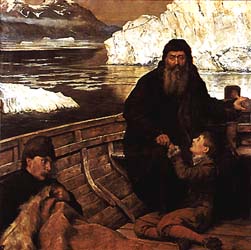 Hudson - 1611 - The Last Voyage - tate Gallery, London by
John Collier
Henry Hudson (Hudson Bay, Canada, 1611) Cast
adrift by mutineers.
Hudson - 1611 - The Last Voyage - tate Gallery, London by
John Collier
Henry Hudson (Hudson Bay, Canada, 1611) Cast
adrift by mutineers.
 Brule with Hurons - Illustrated London News
Etienne Brulé (Canada, 1632) Killed
by Hurons for unknown reasons. Jacques Marquette (Illinois, 1675)
Dysentery.
Brule with Hurons - Illustrated London News
Etienne Brulé (Canada, 1632) Killed
by Hurons for unknown reasons. Jacques Marquette (Illinois, 1675)
Dysentery.
René Robert Cavelieur, Sieur de La Salle (eastern Texas, 1687)
Murdered by his own men.
Louis Jolliet (Gulf of St. Lawrence, Canada, 1700)
James Knight (Marble Island, Canada, 1721)
Vitus Bering (Bering Island, Siberia, 1741) Another scurvy victim.
Marion du Fresne (New Zealand, 1773) Killed by Maoris.
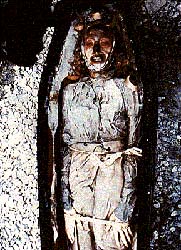 Ill-fated Franklin expedition - body of John Torrington,
Examined by forensic scientists
Ill-fated Franklin expedition - body of John Torrington,
Examined by forensic scientists
James Cook (Hawaii, 1779) Killed in a skirmish with Hawaiians.
Francisco Garcés (mouth of Gila, Arizona, 1781) Killed in an
Indian revolt.
Jean François de la Pérouse (Vanikoro Island, Santa Cruz,
1788) Shipwreck.
John Ledyard (Cairo, Egypt, 1788)
Daniel Houghton (West Africa, 1791) Robbed by his Moor guides, left
alone and died, either from his wounds or of starvation.
Antoine Raymond d'Entrecasteaux (at sea near Java, 1793) Dysentery
and scurvy.
Francisco José de Lacerda (Southern Africa, 1798)
Friedrich Hornemann (Nigeria, 1801?) Disappeared after departure from
Tripoli in 1799, probably died in Nigeria in 1801, possibly of dysentery.
Nicolas Baudin (Port Louis, Mauritius, 1803) Died of illness on the
way home from Australia. Henry Nicholls (Guinea, 1805) Fevers.
Mungo Park (near Bussa, Nigeria, 1806) Drowned while trying to flee
from an attack by tribesmen.
George Drouillard (Three Forks, Montana, 1809) Murdered and mutilated
by Blackfoot Indians.
Johann Ludwig Burckhardt (Cairo, Egypt, 1817) Died of dysentery while
preparing to depart for Timbuktu.
Walter Oudney (Senegal, 1824) Illness.
Alexander Gordon Laing (near Timbuktu, Mali, 1826) Murdered by his
guide.
Hugh Clapperton (Sokoto, Nigeria, 1827) Illness.
Jedediah Strong Smith (near Cimarron River, US, 1831) Killed in a
surprise
attack by Comanches.
Thomas Simpson (near Red River, Canada, 1840) Went mad and killed
himself
and two others.
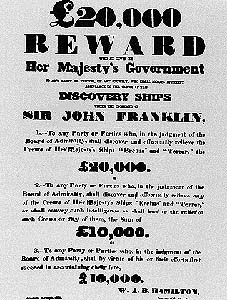 click
to
enlarge
John Franklin (King William Island, Canada,
1847) Died of starvation or possible lead poisoning.
click
to
enlarge
John Franklin (King William Island, Canada,
1847) Died of starvation or possible lead poisoning.
Friedrich Wilhelm Ludwig Leichhardt (Australia, 1848?) Disappeared,
probably in or around the Simpson Desert.
Roderick Mitchell (Australia, 1852?) Drowned.
James Richardson (Kukawa, northeast Nigeria, 1852?) Malaria.
Adolf Overweg (Kukawa?, 1853?)
Joseph René Bellot (Canadian Arctic, 1853) Drowned.
James Sinclair (Oregon Country, 1856) Killed when trying to save a
group of settlers from an Indian attack.
Robert O'Hara Burke & William Wills (Cooper's Creek, Australia,
1861) Starvation.
Henri Moubot (Laos, 1861)
Eduard Vogel (Wadai, Central Africa, 1865) Assassinated on orders of
the Sultan on suspicion of being a spy.
Alexandrine Tinné (near Ghat, Libya, 1869) Killed by roving
Tuaregs.
Charles Francis Hall (northwestern Greenland, 1871) Illness, or possibly
murder through poisoning. "If I can get through this winter I think
I shall be able to live through anything." George Tyson, assistant
navigator on C.F. Hall's 1871 expedition.
David Livingstone (Ilala, Zambia, 1873) Pneumonia and dysentery.
 Inuit Attack Frobisher - c1577 British Museum by John White
Inuit Attack Frobisher - c1577 British Museum by John White
George Washington De Long (Lena River delta, Siberia, 1881)
Nikolai Mikhaylovich Przhevalski (Karakol, Central Asia, 1888) Typhus.
Eduard Schnitzer (Emin Pasha) (Kinema, Congo, 1892) Beheaded by Arab
soldiers on the orders of a local chief.
Salomon August Andrée (Spitsbergen, 1897?) Died of carbon monoxide
poisoning in his tent, in which he wintered after an attempt to reach the
North Pole by balloon.
Robert Falcon Scott (Ross Ice Shelf, Antarctica, 1912) Starvation and
freezing.
Charles-Eugene de Foucauld (Tamanrasset, Algeria, 1916) Probably killed
by a group of Muslims, possibly because he was suspected of being a spy.
Ernest Henry Shackleton (South Georgia, 1922) Heart failure.
Percy Harrison Fawcett (Mato Grosso, Brazil, 1925?) Disappears in the
Brazilian jungle.
Carl Akeley (Belgian Congo, 1926)
Roald Amundsen (off Spitsbergen, 1928) Crashed with his plane when
looking for Nobile, who had crashed before (but was rescued later).
Alfred Lothar Wegener (Greenland, 1930) Exhaustion.
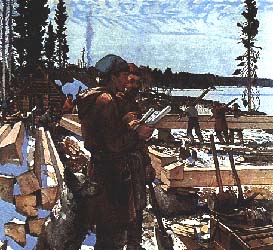 Hearne Building Cumberland House - Public Archives of
Manitoba
Hearne Building Cumberland House - Public Archives of
Manitoba




 It's past
time for us to acknowledge the superb achievement the European Voyages
of Discovery represented. Exploration had captured the European
imagination.
Those star-crossed lovers of the medaieval world, Heloise and Abelard,
named their "love child" Astrolabe, as a tribute to the mariner's
aid, newly reintroduced from classical Greece. Our "own" John
Cabot, who gave Newfoundland its name in 1497, was inspired to sail after
reading of wondrous marvels in the Marco Polo journals. The men who set
sail for unknown and uncharted worlds in frail wooden ships defy our
present
day understanding of the very word "courage". Another word (calenture)
was coined to describe a delusion which was to become a commonplace during
those months-long "voyages to nowhere". For some, the endless
rolling waves "became" the rolling green fields back home, and
the homesick, hapless sailor would simply step off the edge of the ship
"to go for a walk" from which he never returned. Rather than
honour the fortitude and genius of these forgotten men, the remote-control
jockey finds it less taxing to add his voice to a chorus which blindly
condemns them, as he worships contemporary "heroes" who can run
-- and jump! As the following list indicates, an incredible number of the
most famous (and some never known) names paid the ultimate price -- in
some cases, for the sake of an accurate map. The list does not include
the names of those whose illnesses, wounds or other problems resulted in
death after returning home.
It's past
time for us to acknowledge the superb achievement the European Voyages
of Discovery represented. Exploration had captured the European
imagination.
Those star-crossed lovers of the medaieval world, Heloise and Abelard,
named their "love child" Astrolabe, as a tribute to the mariner's
aid, newly reintroduced from classical Greece. Our "own" John
Cabot, who gave Newfoundland its name in 1497, was inspired to sail after
reading of wondrous marvels in the Marco Polo journals. The men who set
sail for unknown and uncharted worlds in frail wooden ships defy our
present
day understanding of the very word "courage". Another word (calenture)
was coined to describe a delusion which was to become a commonplace during
those months-long "voyages to nowhere". For some, the endless
rolling waves "became" the rolling green fields back home, and
the homesick, hapless sailor would simply step off the edge of the ship
"to go for a walk" from which he never returned. Rather than
honour the fortitude and genius of these forgotten men, the remote-control
jockey finds it less taxing to add his voice to a chorus which blindly
condemns them, as he worships contemporary "heroes" who can run
-- and jump! As the following list indicates, an incredible number of the
most famous (and some never known) names paid the ultimate price -- in
some cases, for the sake of an accurate map. The list does not include
the names of those whose illnesses, wounds or other problems resulted in
death after returning home. 







